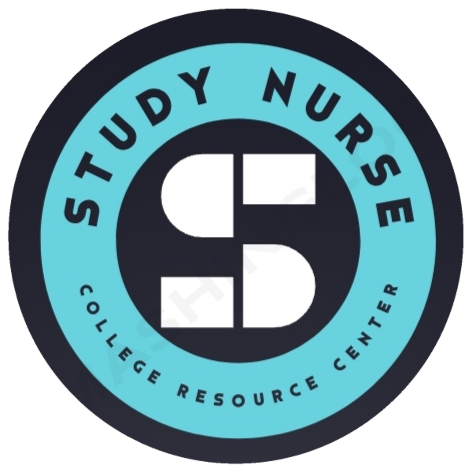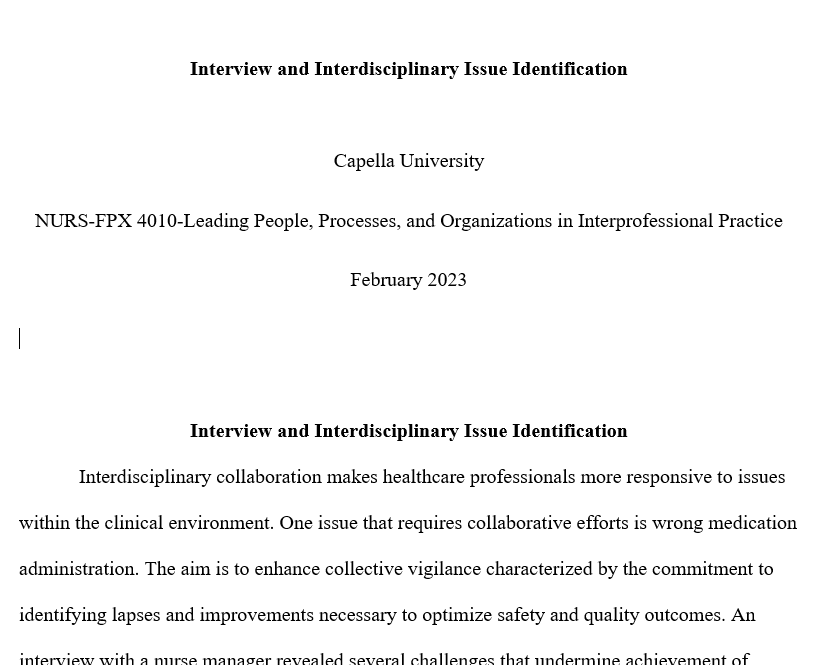NURS-FPX4010_ToddSteven_Assessment 3-1.docx
Interdisciplinary Plan Proposal
Steven Todd
Capella University
NURS-FPX 4010-Leading People, Processes, and Organizations in Interprofessional Practice
February 2023
Interdisciplinary Plan Proposal
Hi everyone, thank you for being part of this session. I will focus on the relevance of interdisciplinary collaboration in preventing medication error. A specific intervention is double-checks, which allows nurses and physicians to collaborate in intercepting errors. Wrong medication administration is among the primary issues with adverse consequences on patients, healthcare professionals, and the organization.
The consequences such readmissions, prolonged hospital stay, additional costs, and declining brand credibility make interdisciplinary collaboration appropriate for encouraging collective vigilance. This plan considers an interdisciplinary approach as a means of informing members of the care team about lapses and their roles in initiating and implementing improvements. The emphasis is on consistent double-checks when handling high-risk medications.
Objectives
- To highlight patients’ vulnerability to adverse drug reactions triggered by wrong medication administration. The objective addresses the need for increased awareness about incidents within and outside the facility (Manias, 2018). The knowledge reminds the care team about individual and collective responsibilities towards intercepting and preventing medication errors.
- To brief the team on double-checks and relevance in preventing wrong medication administration. The objective focuses on making everyone aware of the various steps and procedures of ascertaining the accuracy of a prescribed order to ensure that the right patient receives the right drug (Kim et al., 2020).
- To highlight team-based values, behaviors, and attitudes necessary for enhancing the quality and safety of medication administration. The objective reminds nurses, physicians, and others about team-based functions appropriate for enabling them to use double-checks consistently (Manias et al., 2018).
Questions and Predictions
- How viable are double-checks in preventing wrong medication administration? The prediction is that the care team will appreciate calls for interdisciplinary collaboration when verifying and ascertaining the accuracy of a prescribed order (Berdot & Sabatier, 2018).
- How sustainable is interdisciplinary collaboration in enabling the care team to identify and intercept errors? The prediction is that nurses, physicians, pharmacists, and clinical assistants will appreciate calls for team-based values, beliefs, and behaviors that enhance collective vigilance and interception of errors (Manias, 2018).
- Is it possible to record zero cases of wrong medication administration? The prediction is that with enhanced vigilance and collective responsibility and obligation, it is possible to prevent medication errors and adverse outcomes associated with high risk medications.
Change Theory and Leadership Framework
Competent leaders understand their staff and the clinical environment. The leaders rely on transformational qualities and traits and maintain people-centered interactions across the continuum. In this case, the transformational leader discusses lapses within the clinical environment and allows everyone to share their views, suggestions, and experiences about incidents when handling patients (Hussain et al., 2018).
Knowledge of the enablers of successful changes allow the leader to identify the model that works best in addressing wrong medication administration. The PDSA cycle is vital when encouraging interdisciplinary collaboration designed to enhance vigilance when handling high-risk medications. The theory guides health leaders and the rest of the change team through systematic steps to enable them plan, test, and use the lessons to strengthen the recommended solution (McNicholas et al., 2019).
In this case, the change entails using double-check checklists to verify medications and ensure complete adherence to the rights of safe medication administration. Everyone plays an active role in discussing the current scenario and the need for timely and evidence-based interventions. The leader communicates objectives, allows individuals to ask questions, and makes everyone aware of the predictions associated with preventing wrong medication administration.
McGowan and Reid (2018) described the PDSA model as a framework intended to ensure that the care team learns from tests involving a proposed change and acquires the knowledge, skills, and experiences for producing the best results. As such, a competent leader ensures that everyone understands the progress and, adjustments, and other measures necessary to optimize care outcomes (McGowan & Reid, 2018).
The transformational leader motivates everyone to adopt team-based beliefs, attitudes, and behaviors for successful outcomes. The positive response towards double-checks promote collective commitment to addressing lapses that undermine commitment to sustaining safe, quality, and cost-effective care.
Collaboration Strategy
The team has a nurse educator, nurse manager, nurses, physicians, pharmacists, and clinical assistants. The parties understand frontline roles at the bedside and organizational levels that make them responsible for optimizing safety outcomes. One strategy is encouraging everyone to uphold excellent interpersonal relations (Manias, 2018).
The process allows senior staff to collaborate with junior ones in discussing issues involving wrong medication administration and the need for consistent double-checks. A second strategy is organizing briefings to make everyone aware about the proposed intervention and pathways for accomplishing the best outcomes (Nilsen et al., 2020). Further, the leader should communicate the shared vision for collective buy-in and dedication to using double-checks to overcome the risk of wrong medication administration.
Resources
The organization can utilize multiple resources to initiate interdisciplinary collaboration necessary for preventing wrong medication administration. A nurse educator is crucial to initiate training and briefings on the value of double-checks in promoting collaborative vigilance across the care continuum.
The facility needs case studies and patients’ testimonials retrieved from clinical data repositories. Further, double-check checklists are appropriate to guide the care team through action steps and procedures designed to ensure safe medication administration. This way, everyone understands their roles and the framework for using double-checks to enhance the quality and safety of patient care.
Table 1
Resources
| Resource | Description | Cost ($) |
| Double-check checklists | Checklists guide the care team on procedures necessary to ensure accurate medication administration | 300 |
| Nurse educator | Initiate conversations about double-checks, collective responsibilities, and the best practices for utilizing the intervention to optimize safety outcomes. | 1,200 |
| Case studies | Allow the audience to familiarize with scenarios involving wrong medication administration, consequences, and relevance of double-checks in intercepting risks. | 300 |
| Role-play guides | Allow the team to acquire practical knowledge, skills, and experiences in using double-checking checklists. | 300 |
| TOTAL | 2,100 |
Conclusion
Team-based values, beliefs, and attitudes make nurses, physicians, pharmacists, and others responsive to calls for quality and safe care delivery. Wrong medication administration is among the health issues that require interdisciplinary collaboration. This way, the care team could utilize double-checks to ascertain the accuracy of a prescribed order. The aim is to ensure collective commitment to adhering to the rights of safe medication administration.
References
Berdot, S., & Sabatier, B. (2018). Medication errors may be reduced by double-checking method. Evidence-Based Nursing, 21, (3), 67-67. https://hal.archives-ouvertes.fr/hal-03335317/file/Berdot%20double%20check%202018.full.pdf
Hussain, S. T., Lei, S., Akram, T., Haider, M. J., Hussain, S. H., & Ali, M. (2018). Kurt Lewin’s change model: A critical review of the role of leadership and employee involvement in organizational change. Journal of Innovation and Knowledge, 3(3), 123-127. https://www.sciencedirect.com/science/article/pii/S2444569X16300087
Kim, M. S., Seok, J. H., Kim, B. M. (2020). Mediating role of the perceived benefits of using a medication safety system in the relationship between transformational leadership and the medication-error management climate. Journal of Research in Nursing, 25(1), 22-34. https://journals.sagepub.com/doi/pdf/10.1177/1744987118824621
Manias, E. (2018). Effects of interdisciplinary collaboration in hospitals on medication errors: An integrative review. Expert Opinion on Drug Safety, 17(3), 259-275. https://pubmed.ncbi.nlm.nih.gov/29303376/
McGowan, M., & Reid, B. (2018). Using the Plan, Do, Study, Act cycle to enhance a patient feedback system for older adults. British Journal of Nursing, 27(16), 936–941. https://pubmed.ncbi.nlm.nih.gov/30187794/
McNicholas, C., Lennox, L., Woodcock, T., Bell, D., & Reed, J. E. (2019). Evolving quality improvement support strategies to improve plan–do–study–act cycle fidelity: A retrospective mixed-methods study. BMJ Quality & Safety, 28(5), 356–365. https://pubmed.ncbi.nlm.nih.gov/30886118/
Nilsen, P., Seing, I., Ericsson, C., Birken, S., & Schildmeijer, K. (2020). Characteristics of successful changes in health care organizations: An interview study with physicians, registered nurses and assistant nurses. BMC Health Services Research, 20(147), 1-8. https://bmchealthservres.biomedcentral.com/articles/10.1186/s12913-020-4999-8



